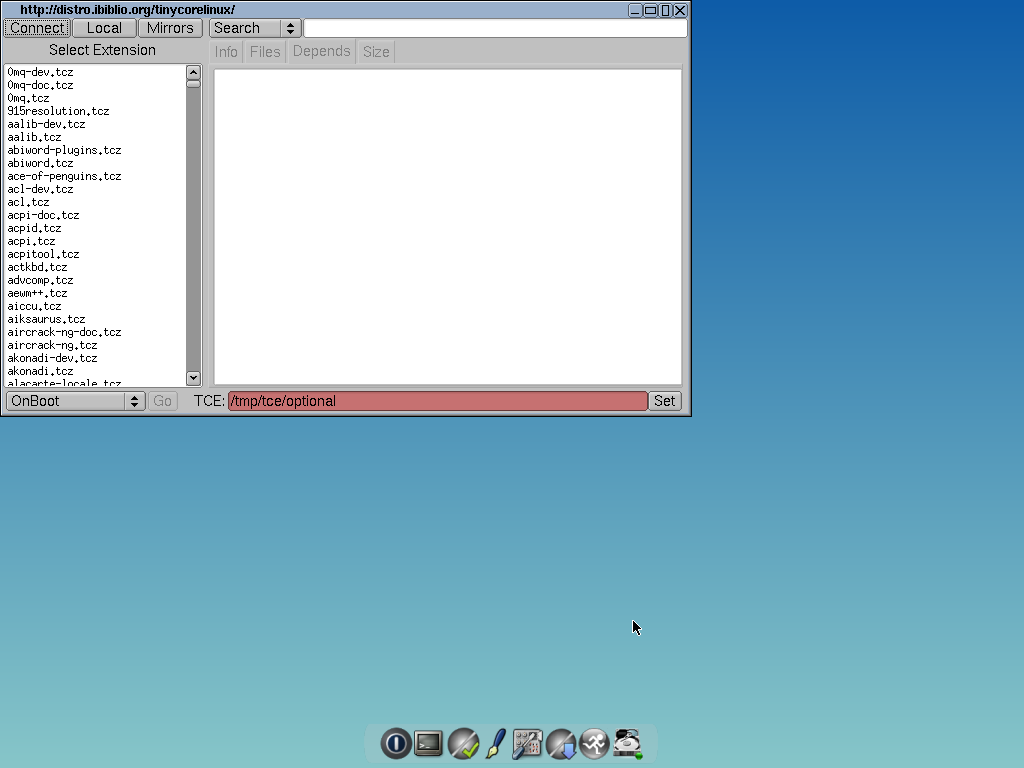

Introduction to Core
Welcome, from the Tiny Core development team.
This is a brief introduction to Tiny Core, a unique and minimalist distribution of the Linux operating system and tools. Experienced Linux users won't miss much by skipping straight to the Core Concepts page.
To find out if Tiny Core is the right distribution for you, this document starts at ground zero and says what Tiny Core is not. A few key features follow, and then the page wraps up with links to further reading, where to get Tiny Core, and where to find help.
Afterwards, you can find even more answers by browsing the wiki or exploring the forums. Many questions already have answers, and writing down new questions will help others in the future.
Again, welcome from the Team, and thanks for trying out Tiny Core.What is Tiny Core?
First, if you don't know what Linux and distributions are, you should read some interesting and conflicting definitions of Linux. Then, read about distributions. In short, the Tiny Core distribution is like a customized version of the Linux kernel and other tools.
Is Tiny Core for me?
If Linux and distributions are confusing to you, then Tiny Core might not be for you. To help you decide, you need to know a few things about Tiny Core.
To get started, Tiny Core is:
Not a duplicate of another really common operating system. Tiny Core doesn't have a pretty boot screen, or stock wallpaper, and Tiny Core certainly doesn't have its own advertising campaigns.
Not a 'turnkey' operating system. Tiny Core can help you do what you need to do, but Tiny Core stays tiny by not including tools like a browser or word processor (but Tiny Core can help you download and install those really quickly).
Not for everyone. Tiny Core is fast, powerful, and flexible. You can use Tiny Core without much technical knowledge, but, like any strong tool, Tiny Core becomes really useful if you know how to use it. Great starter skills could include command line usage, simple shell scripting, and Linux file and permission management, and some reasonably fast typing skills.
If you aren't scared off yet, you need to know that there are some characteristics that make Tiny Core a really unique Linux distribution.
Why is Tiny Core special?
Tiny Core is:
Very Small. At 10 megabytes, Tiny Core is 1/400 to 1/100 the size of the most widely used operating systems in the world (even compared to most Linux distros). That makes Tiny Core flexible enough to be stored and run from usb sticks, a just-about-full CD, or even embedded devices. hardware.
Linux. Tiny Core uses the Linux Kernel and a set of command-line (text interface) tools including busybox.
A GUI Desktop. Tiny Core has a flexible and fully-customizable Graphical User Interface Desktop. Mouse, keyboard, and screen support basically works out-of-the-box thanks to FLWM, the FLTK Desktop. You can also quickly install and try out a variety of other desktops and interfaces including Fluxbox, XFCE, OpenBox, IceWM, Joe's WM, LXDE, and others.
Minimal. Tiny Core does not 'ship' with most end-user software. Instead, Tiny Core lets you quickly and easily compare, select, download, and install your preferred web browser, word processor, music player, and other software.
Unusually Stable. Every time Tiny Core loads, it is brand-spanking new. That means Tiny Core just doesn't get a blue screen. Instead of installing programs into the system file space and risking damage to the system files, Tiny Core uses program 'extensions' that are re-prepared at each reboot ... and they are prepared fast.
Unusually Fast. Unlike most operating systems, the Tiny Core can run completely from RAM. Individuals with RAM to spare can even use Tiny Core to load and run their programs from RAM (you didn't know your computer could run Open Office and Firefox so quick). Experienced users can still install Tiny Core to disk, but Tiny Core can run in 48 megabytes of RAM ... or less.
Internet ready. Tiny Core almost always finds your network card right right away. You'll be adding applications and tools after an unusually quick boot. You can even come back here and ransack the forums if you find you need help.
Available even smaller. Linophiles that get things done without a GUI can get the MicroCore, a version of Tiny Core without X that is under 7 MB.
An open source community. Tiny Core is under active community development, led by a team of really dedicated people. You can find answers and ask questions in the forum, add your own experiences to the wiki, help add extensions (programs) to the Tiny Core Repository, and read enough Tiny Core to make your head spin.
Where to now?
Even if you're itching for the download, take time to read our Quick & Easy Overview. It covers the basics of running Tiny Core from CDROM and/or USB pendrive. Most will find learning Tiny Core the quick and easy way a better starting point.
For advanced information read Core Concepts. It explains how Tiny Core stores and loads your data and programs – it's not traditional (in a good way).
If Tiny Core still sounds good, then get Tiny Core. Don't forget to read both Quick & Easy and Core Concepts!
More questions? Try the forums, and the wiki.
Thanks.
Tiny Core is still a young project, but it is fortunate to attract some great people. Thanks again from the Tiny Core Team.
Catch you in the forums!
dentonlt, 14 February 2009
Источник: https://distro.ibiblio.org/tinycorelinux/intro.html

-
-
-